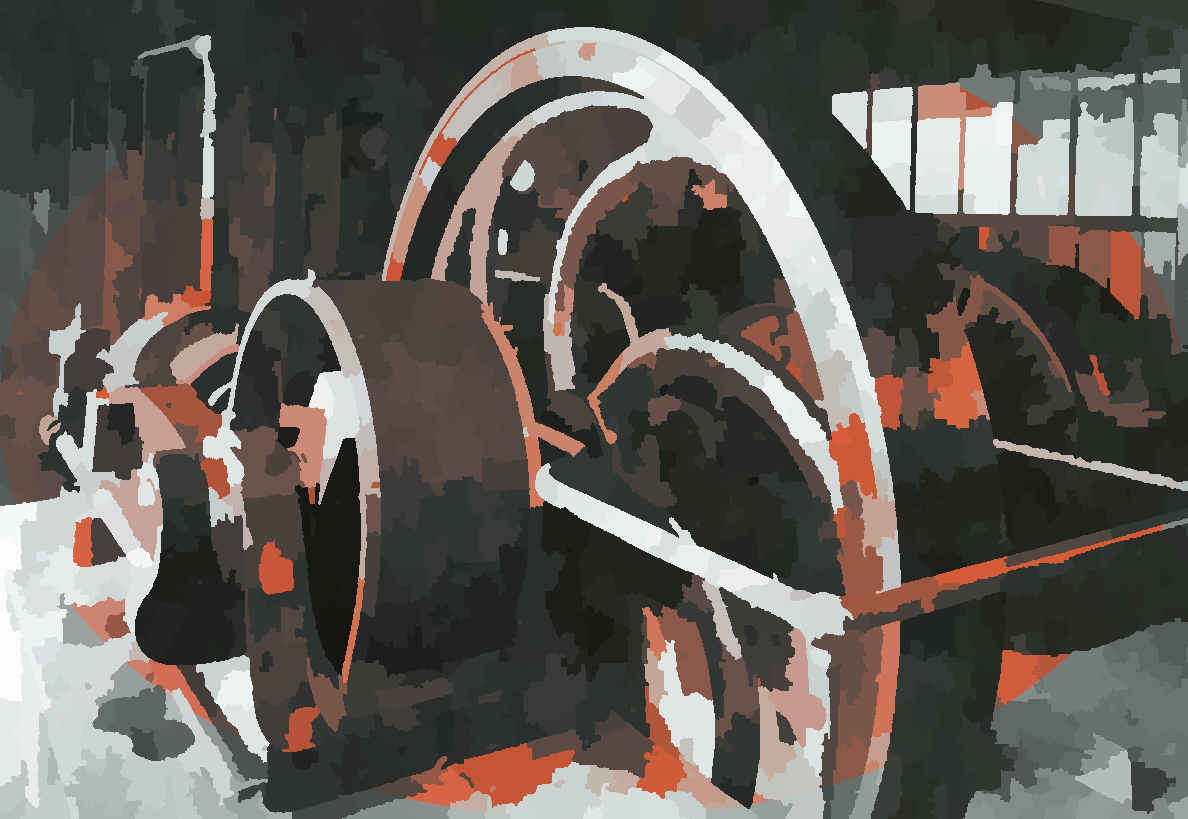|
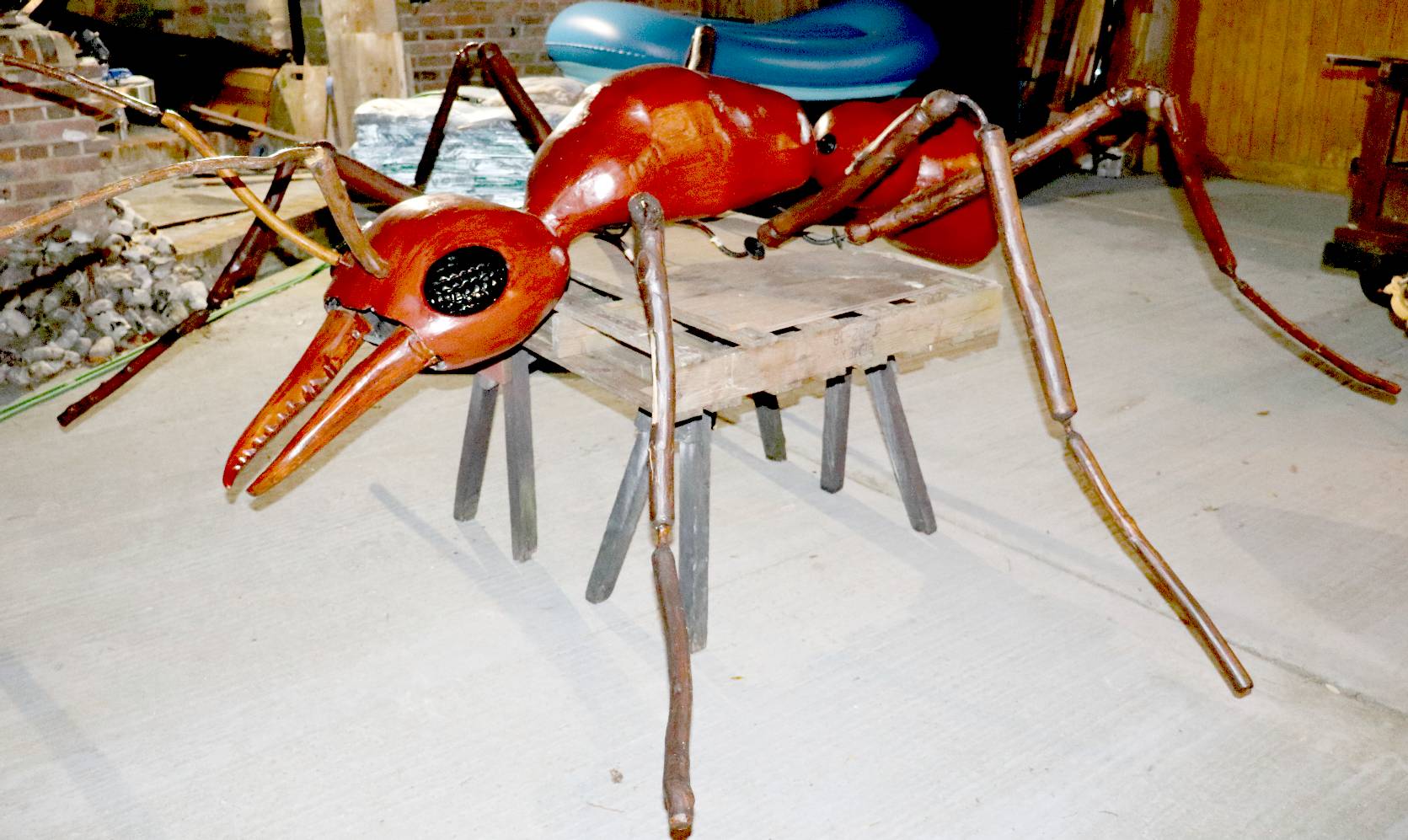
DINOBOT
- The world's largest Australian Bulldog ant model, 300 times normal
size, was made in Herstmonceux
In
the late 1970s, Max
Askaroff, brother of Alex
Askaroff, brought back a bulldog ant (myrmecia regularis) from his travels in
Australia. Even compared to the largest wood ant in the UK, this specimen was huge, and it had attacked and eaten a tarantula and a scorpion in the same transit jar.
How 'Maxy,' as he was known, managed to get them all into one large jar alive, we cannot
imagine. Dangerous to say the least. That the Bulldog ant had come out
victorious against such deadly foes, was impressive enough a feat, to spur all concerned on, to want to learn more about this tough little bush animal.
Especially since they grow up to 40mm in length and can run faster than a man.
It was the stuff of science fiction. And that, coupled with the
developing disciplines of robotics, mechatronics and animatronics, triggered the as yet
incomplete story: Jimmy
Watson and The Magic Dinobot. The Christmas wish of a budding AI
programmer.
As
you may notice from the videos on this page, Bull Ants are very
dangerous insects. Whereas, our 'Anthony' is friendly to humans.
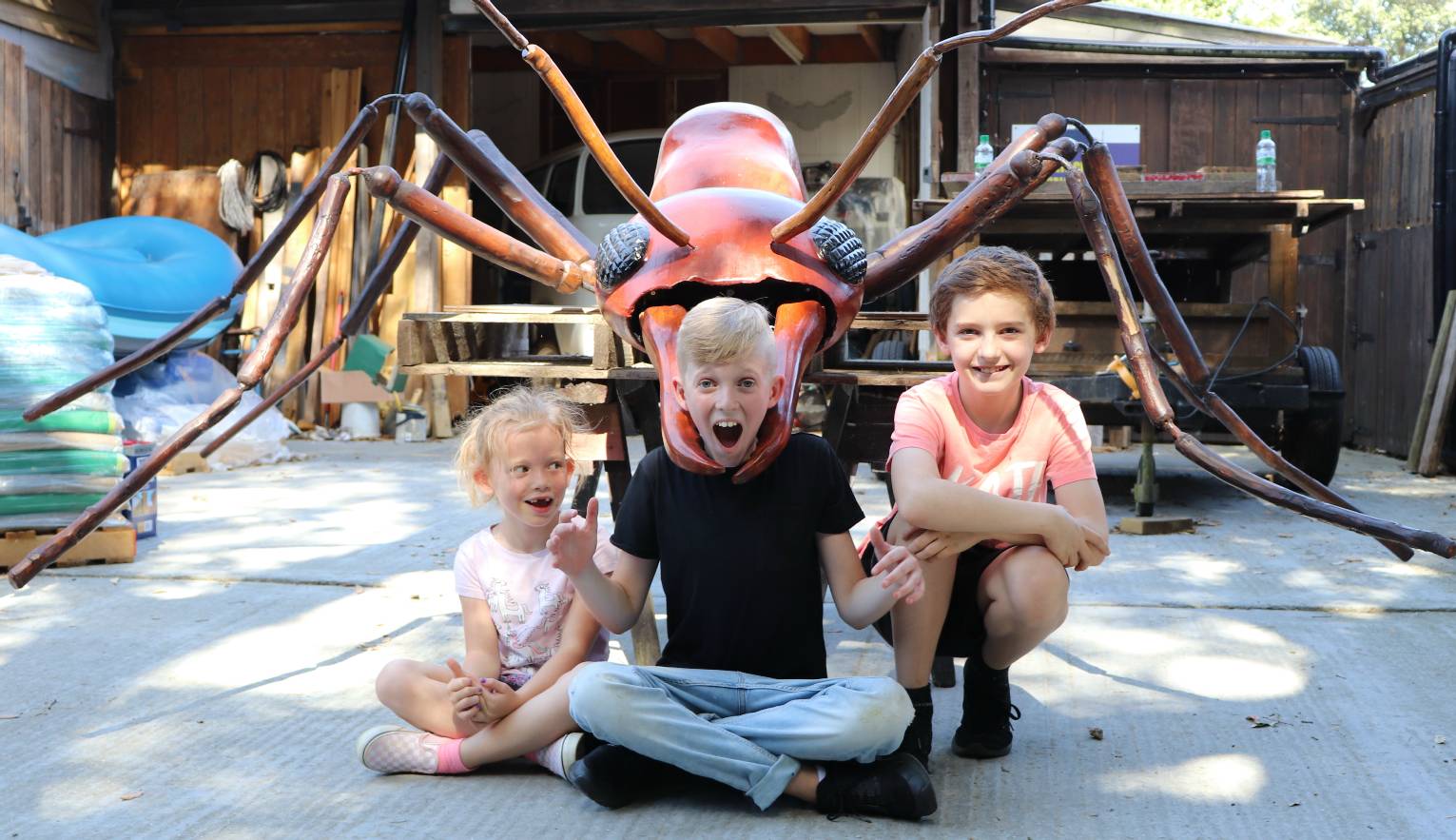
THE
MAGIC DINOBOT
- Ideal as a live action network streamed TV series
JIMMY
WATSON'S MAGIC DINOBOT
Jimmy Watson is just an ordinary boy. He attends an ordinary school. He is a loner with just a few friends, and quite a few enemies. He often wanders off into a world of his own in classes, not listening to his teachers fully, on those occasions. Although he truly admires his science master,
loves physics and maths lessons, and especially metalwork, when he gets to make things in steel and other exotic materials.
This was all another world of wonder for young Jimmy.
Jimmy's special talent is programming. He was taught that at school quite early on. He was always in demand in teams for robot competitions. The only time he was popular at school. With his programming, and provided the robot was sturdy enough, his team would nearly always win.
Jimmy would read books on robotics from cover to cover. Sometimes, under the covers by torchlight. In the town library, he would always check out
any new books on animatronics, and mechatronics. His favorite subjects. Then one day in the covers of a robotics magazine, Jimmy saw a kit for a hexapod, designed for developers of artificial intelligence.
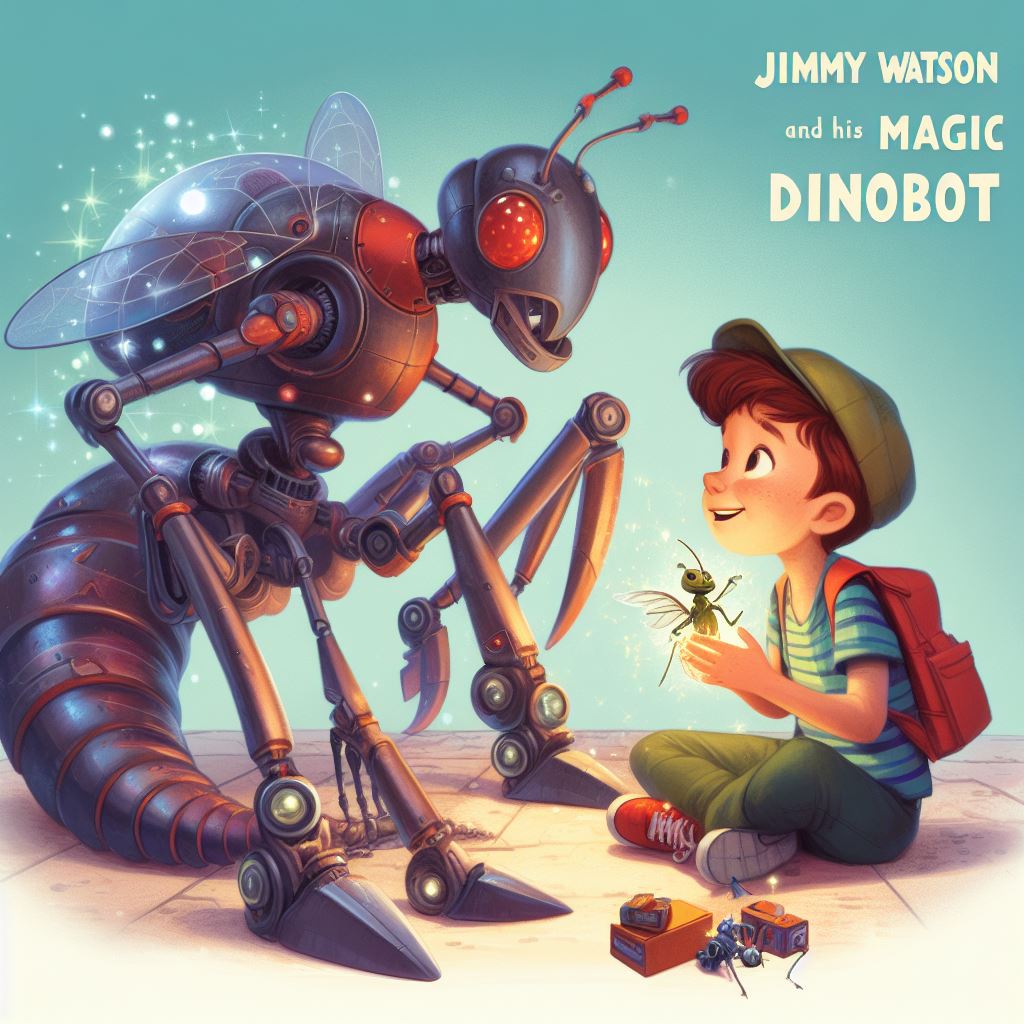
THE
MAGIC DINOBOT
- Could be a Disney/Dreamworks/Pixar style animation for all the family
at Christmas
|
CHARACTERS:
ANTAGONISTS
|
-
|
DESCRIPTION
|
|
|
-
|
|
|
Detective
Harriet Rose Winter
|
-
|
Special
adolescent liaison officer
|
|
Harold
Holland
|
-
|
Chief
Constable, Metropolitan police, Scotland Yard
|
|
Jamie
Moonlight
|
-
|
School
chum of Johnny Baxter, bully & vandal who hates nerds
|
|
Johnny
Baxter
|
-
|
School
bully, Jimmy's nemesis (The Johnson)
|
|
Jack
Mason
|
-
|
US
CIA operative, enhanced soldiers programme DARPA
|
|
Inspector
Nigel Matthew Coltman
|
-
|
Stationed
at Deer Paddock, Hailsham
|
|
..
|
-
|
..
|
|
|
-
|
|
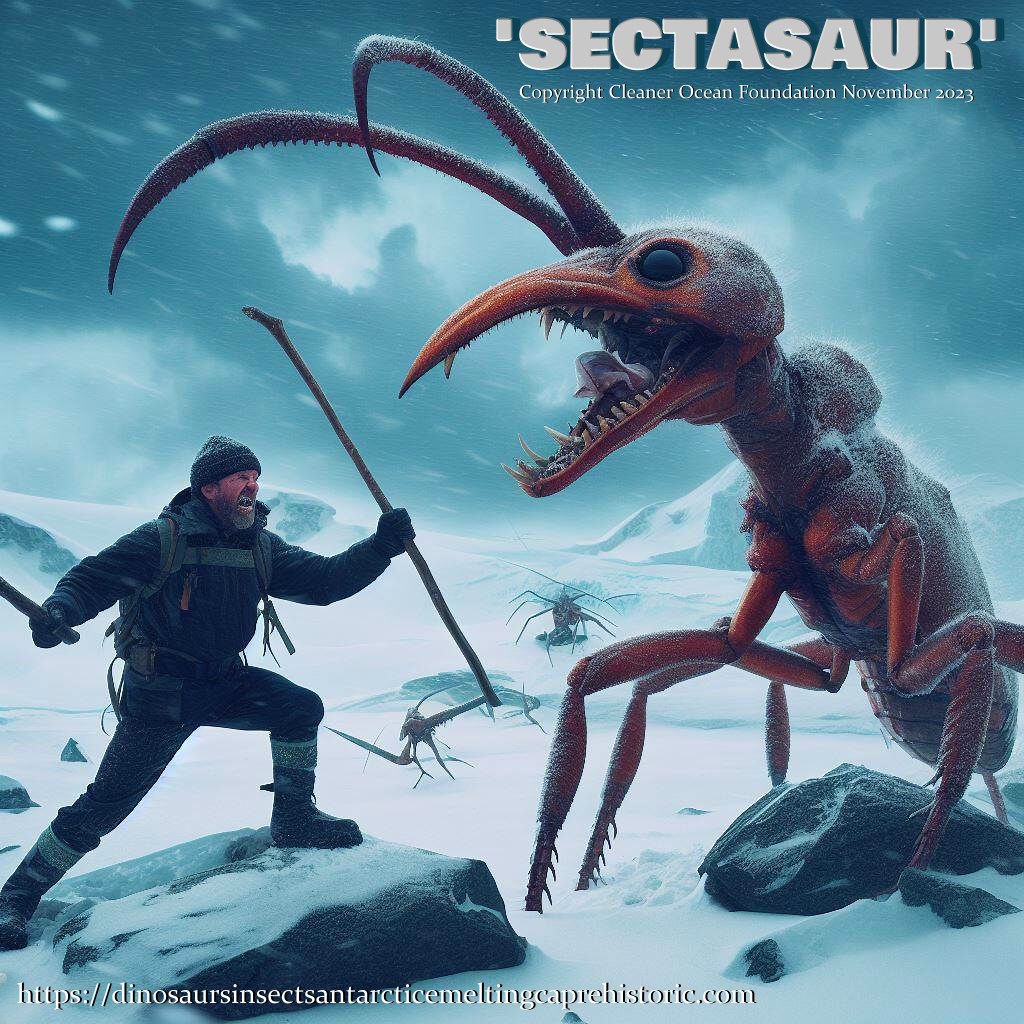
SECTASAUR
- Movie goers seem to enjoy a good monster movie, the bigger the better:
Alien, Godzilla, Jurassic Park, King Kong
SECTASAUR
This
Jameson Hunter story, is a variation on the 1954 classic movie
"THEM" with a tinges of Alien,
Godzilla,
King
Kong, and "Jurassic
Park" thrown in to the mix. Set in a future where the planet is
boiling from fossil fuels, and the Antarctic ice cap is rapidly melting. Though not far
from the truth today, this story was conceived over thirty years ago,
the rights recently acquired. So far, it has only been developed in
outline form. With Kulo-Luna
and Cleopatra's
Mummy, far ahead in development, and recently published as full
(draft) scripts, as part of the John
Storm franchise. Jameson Hunter, is a story developer, looking to
publish graphic novels, subject to favorable market surveys.
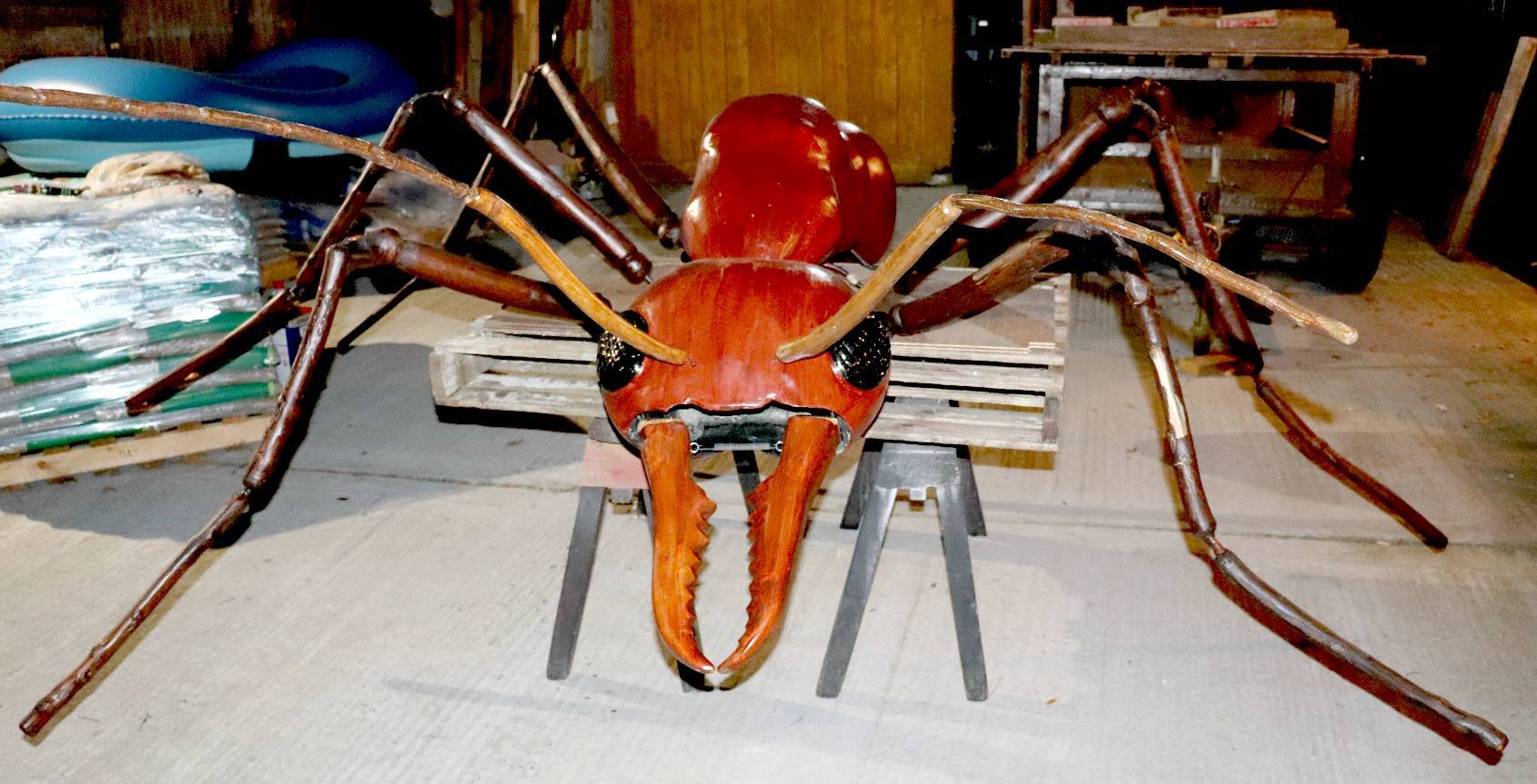
View
from the front. Anthony is actually the artwork for a book: Jimmy Watson
and the Magic Dinobot, from the Jameson Hunter
Ltd., stable. Deemed to be suitable for adaptation to a TV series: Jimmy dreams of building a giant robot ant as a special project, then one day his dreams come true when the robot he has built is transformed into a living, breathing, companion.
CHAPTER
3, CH4,
CH5
The
same artwork also works as a John
Storm film: SECTASAUR -
OUTLINE: At a time in the not too distant future, the ice melts at both poles revealing features on the land not seen for 200 years. A converted Frigate, the US Arktos is discovered at the South Pole locked into melting ice. She has been missing since an expedition in 1838. A famous ship at the time, formerly the USS Essex, she had been bought at auction in 1837 and hastily refitted by a group of explorers who had come by a fossilized artifact thought to be of considerable archaeological importance. The fossilized jaw was said to have originated in Antarctica brought back as a souvenir by the Russian explorer Fabian Gottlieb von Bellinghausen during his fabled 1820 expedition.
Another fantastic discovery is a labyrinth of tunnels beneath the ice, dated by scientists to be millions of years old. Mysteriously, the scientist who discovered and dated the tunnel complex disappears, but not before his find is leaked to a Sky news researcher on the Discovery channel.
In Australia it is law that building sites have to be cleared of bulldog ants before work can begin. They can paralyze a man with
multiple stings. So by all means study these social miracles, but be careful - they are very aggressive and they bite.
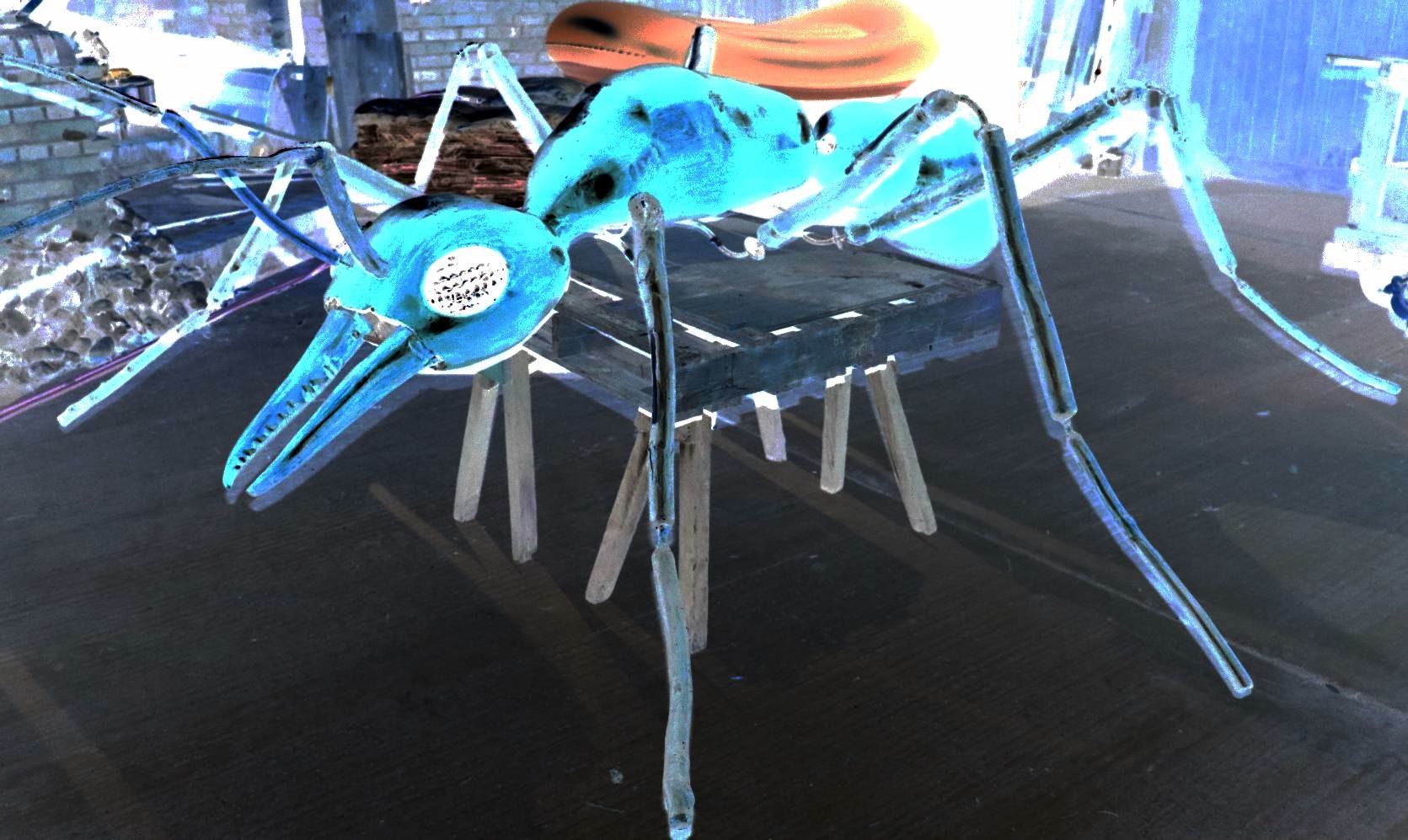
IN SCIENCE & TECHNOLOGY - (Myrmecology, Biomimetics, Ant colony optimization algorithms)
Observed by humans since the dawn of history, the behavior of ants has been documented and the subject of early writings and fables passed from one century to another. Those using scientific methods, myrmecologists, study ants in the laboratory and in their natural conditions. Their complex and variable social structures have made ants ideal model organisms.
Ultraviolet vision was first discovered in ants by Sir John Lubbock in 1881. Studies on ants have tested hypotheses in ecology and sociobiology, and have been particularly important in examining the predictions of theories of kin selection and evolutionarily stable strategies. Ant colonies may be studied by rearing or temporarily maintaining them in formicaria, specially constructed glass framed enclosures. Individuals may be tracked for study by marking them with dots of paint.
The successful techniques used by ant colonies have been studied in computer science and robotics to produce distributed and fault-tolerant systems for solving problems, for example Ant colony optimization and Ant robotics. This area of biomimetics has led to studies of ant locomotion, search engines that make use of "foraging trails", fault-tolerant storage, and networking algorithms.
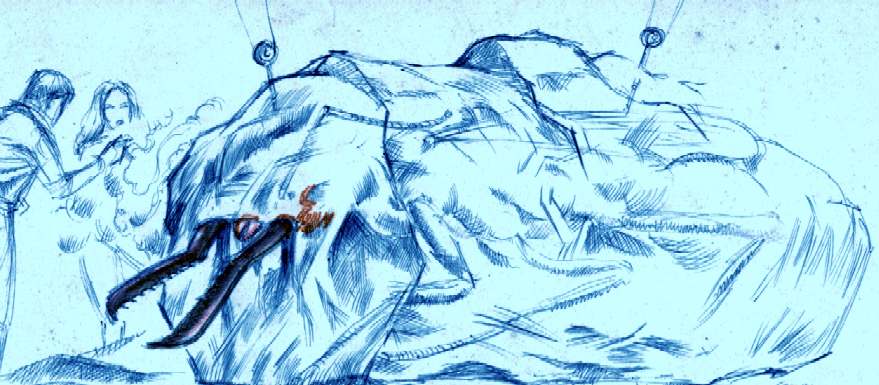
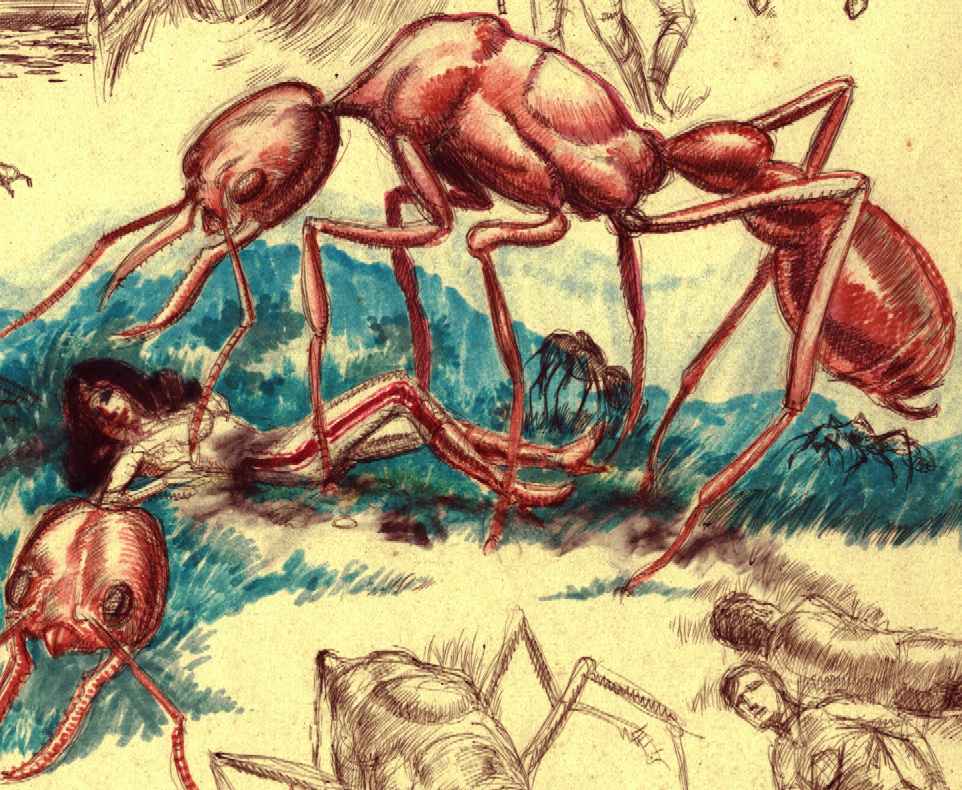
SECTASAUR
- MI6 and the CIA decide to send in John Storm, an expert diver, archaeologist and enthusiastic adventurer to report on the goings on. Storm is happy to oblige if it means adding to his DNA collection for his usual fee - a hefty donation to his favourite charities. Having equipped his solar powered ship, the Elizabeth Swan, with arctic clothing and supplies, he, Dan Hawk and Charley Temple sped from the Southern Ocean to the Weddell Sea and there to Deception Island, an extinct volcano.
The team set up camp onshore and soon the trio locate the excavation site, then using the 'Ark' (a DNA database) Storm uncovers disturbing new evidence to support a theory that dinosaurs were not wiped out by a meteor striking the earth (creating an artificial ice age), but by very efficient hunting animals related to the Vespoidea or Myrmecia Giganticus taxonomic group, part of a long extinct branch of the family Formicidae of the order Hymenoptera - insects in plain speak. This strain appears to have evolved rapidly by adaptive radiation. From the evidence on site it seems that these deadly animals hunted in packs in significant numbers to overwhelm much larger animals (an example of which may be seen in 6mm army ants overcoming a 40mm bull ant and just about any animal in the jungle that gets in their way).
From DNA analysis aboard an energy depleted Elizabeth Swan, Storm estimates that this species grew to between 3-5 metres and that they were warm blooded with a high tolerance to low temperatures, with a kind of lung to supply vast amounts of oxygen to their spiracles via an organ pumped dorsal aorta to the other organs in an otherwise classic exoskeleton arrangement. Storm and Hawk realize the danger if such a creature were ever to be introduced on the mainland and with evidence that eggs have been removed from the site, alert MI6 and the CIA to the danger.
SECTASAUR™
- CHAPTERS (suggested sequence order)
PART
1
CHAPTER
1: US ARKTOS 1838 EXPEDITION - The ice melts at both poles
revealing features on the land not seen for thousands of years. A
converted Frigate, the US Arktos is discovered at the South Pole locked
into melting ice, then freed.
CHAPTER
2:
TUNNEL COMPLEX - Discovery of a labyrinth of tunnels beneath the
ice, dated by scientists to be many millions of years old, is leaked to
Jill Bird, BBC world service, via Sky news and Discovery Channel.
Supporting John Cleves Symmes theory of 1818.
CHAPTER
3:
GOLD RUSH - Three expeditions launched by competing concerns,
Swedish led by Bjorn Atlas, Multinational headed by Cathy
Carter, backed
by the CIA.
The third funded by Chinese pharmaceutical giants, led by Lin Po
Chang.
CHAPTER
4:
CALL FOR JOHN STORM - MI6
and the UN
decide to send in John
Storm and the Elizabeth
Swan. Dan
Hawk and Charley
Temple speed from the Southern
Ocean to the Weddell Sea and there to Deception Island, an extinct
volcano.
CHAPTER
5: IT'S MURDER ON THE ICE - Several fatal accidents occur in quick
succession, then an egg clutch is discovered in a section of a tunnel.
Chang eliminates the remaining opposition. Then nurtures one egg through
a simulated incubation.
CHAPTER
6:
BOUND FOR ENGLAND - The creature is smuggled aboard
Ice Patrol survey vessel 'KoolArctic' bound for England, eats two crew
members. Second mate on KoolArctic reports the chaos aboard vessel to
the British Admiralty, abandons ship.
CHAPTER 7: BASECAMP - John's team set up camp onshore, locate the
excavation site, using the 'Ark' (a DNA database) Storm uncovers
disturbing new evidence to support theory that dinosaurs were not
entirely wiped out by a meteor striking the earth.
PART
2
CHAPTER
8: WHEN DINOSAURS RULED THE EARTH - Confirmed, they lived when
dinosaurs ruled the earth. Dinosaurs starve in volcanic/asteroid winter.
Sectasaurs have higher tolerance to freezing conditions, eat
competition, then hibernate.
CHAPTER 9:
WORST FEARS CONFIRMED - From DNA
analysis aboard energy depleted Elizabeth
Swan, Storm estimates species grew to between 3-5 metres, were warm
blooded with high tolerance low temperatures. Team realize danger to
humans, alert MI6 & CIA
to the danger.
CHAPTER 10: -
ATLANTIC EXPRESS - Storm and crew head to
England at high speed. Meanwhile Chang has landed in Portsmouth.
CHAPTER 11: HAMPSHIRE - The giant prehistoric animal jumps ship,
feeds on ponies, gaining attention of Hampshire police, relayed to MI6
and thence to John Storm.
CHAPTER
12:
BUCKLERS HARD - Storm head up the Beaulieu River to
Bucklers Hard, following pony corpses toward a wooden area near Worts
Gutter (Furzey Lane). Storm calls MI6 for backup.
CHAPTER 13:
CAT & MOUSE - Storm and Temple
play cat and mouse with Sectasaur - when the giant insect came up from
behind over the brow of a ravine and knocks Charley nearly unconscious.
Storm strikes the creature with an axe, causing partial shock.
PART
3
CHAPTER
14: FIRST AID - Charley and John patch creature's wound with
antiseptic and bandages. The giant insect feigns immobility. Understands
dialogue between John and Charley is not aggressive or threatening, and
marks these two humans down as allies.
CHAPTER 15: SECTASAUR RESCUES JOHN - John panics with axe.
Creature lashed out in reflex throwing John over a ledge. John at the
mercy creature. The huge insect puts itself at risk to pull John up to
safety. Meanwhile government troops are closing in.
CHAPTER 16:
PUZZLING SITUATION - John dusts himself, while
magnificent insect cleans itself. John offers hand palm up to the
creature. The animal studies with both feelers, tickling him. John's
heart pounding, at risk of amputation, enjoying leap of faith.
CHAPTER 17: ALL FRIENDS - Charley joins from bracken and saw the
interaction between John and the insect. She proffers her hand, the
prehistoric insect smelled her all over with its antennae. Charley
giggled at the friendly touch.
CHAPTER 18: HOSTILE FIRE - Troops fire wounding animal. John
& Charley both leap in front of insect yelling to stop firing, but
Charley is shot in the arm and screams. The giant insect moves to
protect them both from the gunfire, taking more hits and one to the
head.
CHAPTER 19: ATTACK SUBSIDES - John and Charley shout as loud as
they can, stopping firing. They reach insect. It raised its feelers,
Charley and John take one each, and the trio embraced for a minute, then
the creature subsided its antenna went limp - it was gone.
CHAPTER
20:
NO REMORSE - John & Charley welling up inside, tears. A
well-built soldier is delighted at kill. "Yes," cried the
soldier. "Yes," said John, punching the soldier out. Up to
that point other military thought they had saved their lives.
CHAPTER 21:
EPILOGUE & DEBRIEFING - John files a
report with the United
Nations and MI6,
advising of a great loss to science. Keep watching brief for any
repeats, finds, etc. Antarctic Area
51.
ANTARCTICA | CHAPTERS |
CHARACTERS
| DINOSAURS
| INSECTS | MOVIES
| PLOT
OUTLINE
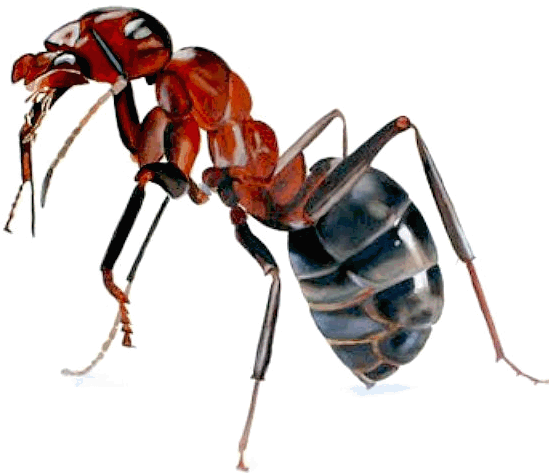
RELATIONSHIP WITH HUMANS
Ants perform many ecological roles that are beneficial to humans, including the suppression of pest populations and aeration of the soil. The use of weaver ants in citrus cultivation in southern China is considered one of the oldest known applications of biological control. On the other hand, ants may become nuisances when they invade buildings, or cause economic losses.
In some parts of the world (mainly Africa and
South
America), large ants, especially army ants, are used as surgical sutures. The wound is pressed together and ants are applied along it. The ant seizes the edges of the wound in its mandibles and locks in place. The body is then cut off and the head and mandibles remain in place to close the wound.
Some ants of the family Ponerinae have toxic venom and are of medical importance. The species include Paraponera clavata (Tocandira) and Dinoponera spp. (false Tocandiras) of South America and the Myrmecia ants of Australia.
In South Africa, ants are used to help harvest rooibos (Aspalathus linearis), which are small seeds used to make a herbal tea. The plant disperses its seeds widely, making manual collection difficult. Black ants collect and store these and other seeds in their nest, where humans can gather them en masse. Up to half a pound (200 g) of seeds may be collected from one ant-heap.
Although most ants survive attempts by humans to eradicate them, a few are highly endangered. Mainly, these are island species that have evolved specialized traits. They include the critically endangered Sri Lankan relict ant (Aneuretus simoni) and Adetomyrma venatrix of Madagascar.
It has been estimated by E.O. Wilson that the total number of individual ants alive in the world at any one time is between one and ten quadrillion (short scale). According to this estimate, the total biomass of all the ants in the world is approximately equal to the total biomass of the entire
human
race.
SECTASAUR™
- CAST
|
CHARACTERS:
PROTAGONISTS
|
DESCRIPTION
|
|
|
|
|
Ark,
The
|
The
world's largest, most comprehensive interactive DNA database
|
|
BioCore™
|
A
digital communication interface for the human brain
|
|
Captain
Nemo
|
AI
onboard computer system
|
|
Charley
Temple
|
Researcher
& camerwoman,
good friend of John Storm
|
|
CyberCore
Genetica™
|
The
world's smallest, fastest and most powerful nano supercomputer
|
|
Dan
Hawk
|
Electronics
& computer wizard, crew
member Elizabeth Swann
|
|
Dr
Roberta Treadstone
|
Blue
Shield, Newcastle University, England
|
|
Elizabeth
Swann
|
Fastest
solar/hydrogen ship & floating laboratory
|
|
Excalibur,
Pendragon & Merlin
|
Anti
piracy weapon & ship security system
|
|
George
Franks
|
Legal
and intelligence trust manager, Swindles
& Gentry
|
|
Gohsts
of Explorer's past
|
Hauntings
of Ernest
Shackleton, Robert
Scott & Roald
Amundsen
|
|
HMM
Atlantic Express
|
A container cargo vessel operated by Huyndai Merchant Marine
|
|
HMS
KoolArctic
|
'Arktiki,' British Antarctic Survey icebreaker
|
|
HAL
|
The
onboard AI supercomputer ship manager
|
|
Jeep
Cherokee
|
John
Storm's trusty 4x4 with eco conversion
|
|
Jill
Bird
|
Senior
BBC news world service anchor
|
|
John
Storm
|
Ocean
adventurer, amateur anthropologist, & marine archaeologist
|
|
Katy,
Kitty
|
The
ships cat and lucky mascot
|
|
King
Charles III
|
British
& Commonwealth head of state
|
|
King
William V
|
British
& Commonwealth head of state
|
|
Musket
Meloni
|
Billionaire
conservationist philanthropist
|
|
Pope
Peter Benedict
|
Spiritual
friend of John Storm
|
|
Professor
Douglas Storm
|
John
Storm's uncle, designer
of Elizabeth Swann
|
|
Professor
Jacques Pierre Daccord
|
UNESCO
sunken realms division, conservationist
|
|
Patricia
Leopard
|
Cleopatra's
assumed name (Trish)
|
|
Sam
Hollis
|
BBC
& Sky freelance investigative reporter Caribbean regions
|
|
Scott
Tremaine
|
Treasure
hunting professional & ships captain
|
|
Shui
Razor
|
Japanese
privateer,
ocean conservationist and historian
|
|
Sir
Rodney Baskerville
|
Professor
of Maritime History & oceanographer
|
|
Steve
Green
|
Freelance
reporter, friend of Charley Temple
|
|
Suki
Hall
|
A
marine biologist, admirer of John's work
|
|
Tom
Hudson
|
Sky
News Editor, always looking for an exclusive
|
|
Trisha
Lippard
|
Cleopatra's
call sign to protect her royal identity
|
|
UK
Prime Minister
|
UK's
leading politician (Honest Johnson) a truthful candidate
|
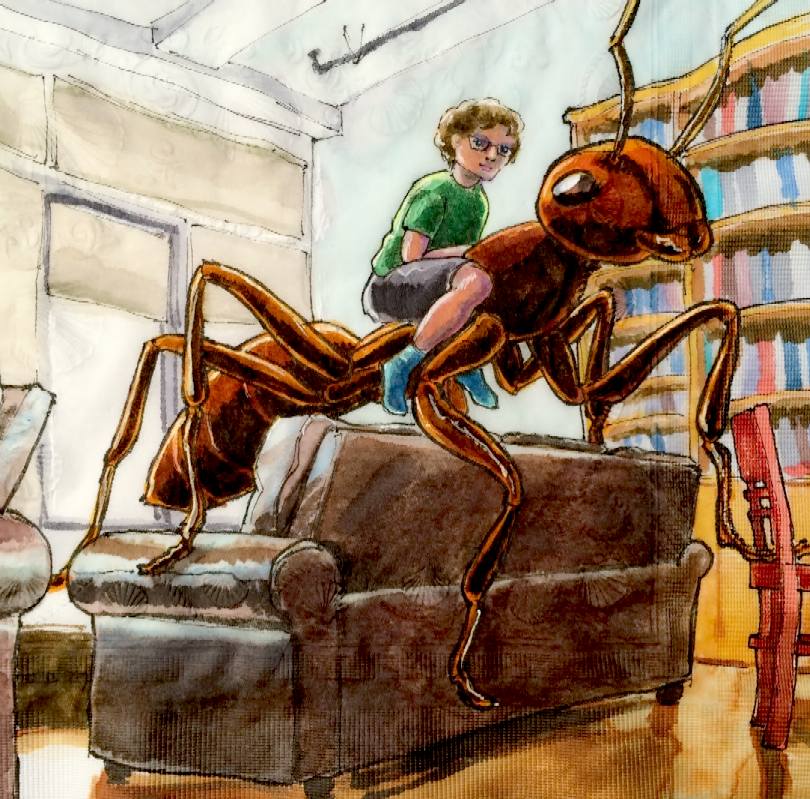
JIMMY
WATSON
- Having built his giant robot ant, it comes to life to play. When his
mother finds out, there will be hell to pay. Jimmy had not thought that
far ahead. Fortunately, Anthony, freezes when other humans appear.
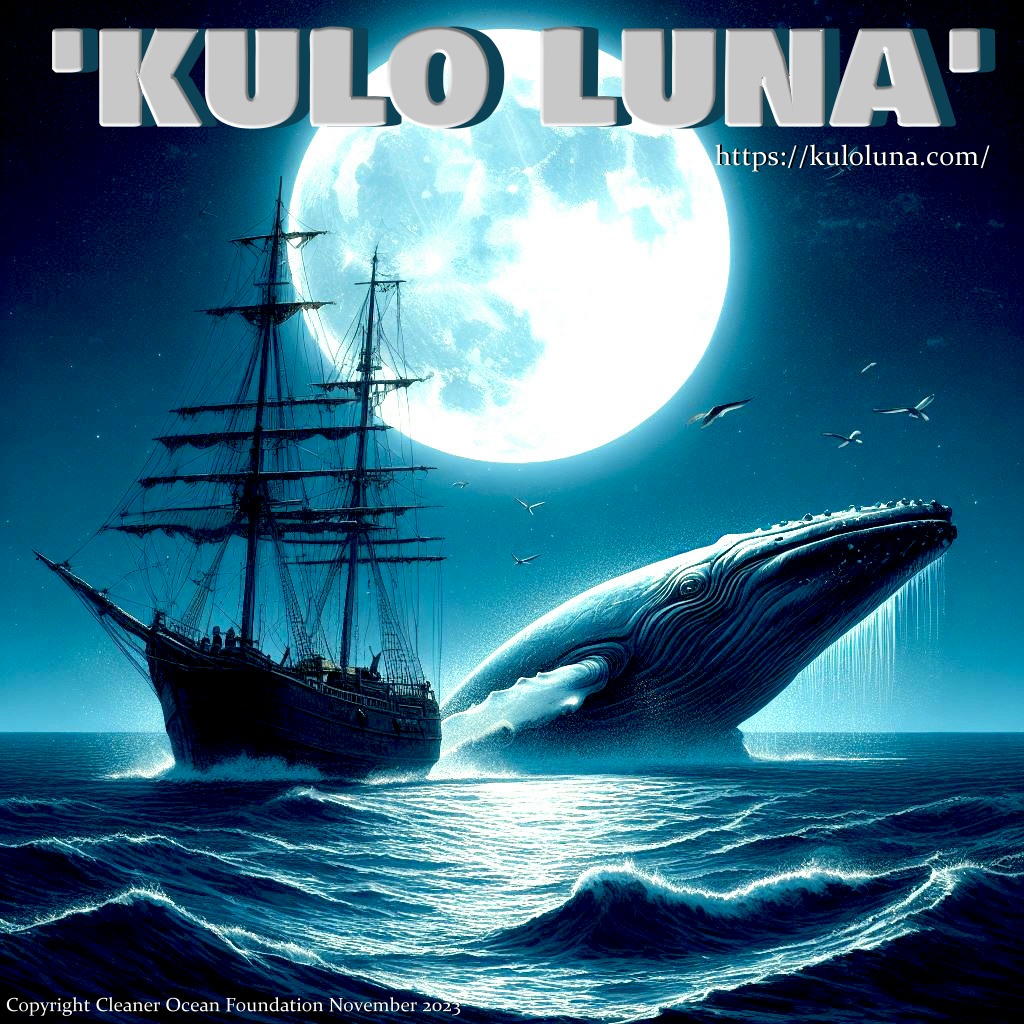
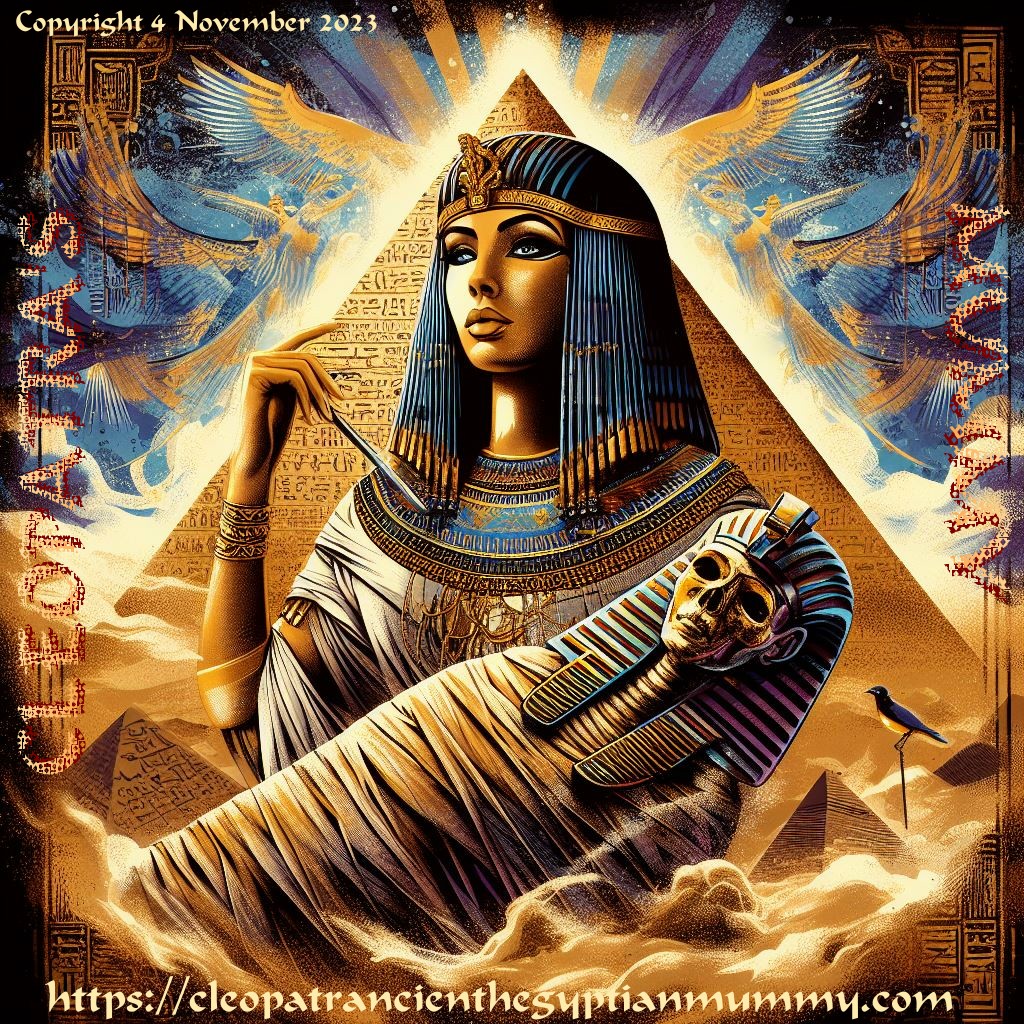
OTHER
TITLES - Cleaner Ocean Foundation has produced two full scripts for the
above stories.
RELATIONSHIPS WITH OTHER ORGANISMS
Ants form symbiotic associations with a range of species, including other ant species, other insects, plants, and fungi. They also are preyed on by many animals and even certain fungi. Some arthropod species spend part of their lives within ant nests, either preying on ants, their larvae, and eggs, consuming the food stores of the ants, or avoiding predators. These inquilines may bear a close resemblance to ants. The nature of this ant mimicry (myrmecomorphy) varies, with some cases involving Batesian mimicry, where the mimic reduces the risk of predation. Others show Wasmannian mimicry, a form of mimicry seen only in inquilines.
Aphids and other hemipteran insects secrete a sweet liquid called, honeydew, when they feed on plant sap. The sugars in honeydew are a high-energy food source, which many ant species collect. In some cases the aphids secrete the honeydew in response to ants tapping them with their antennae. The ants in turn keep predators away from the aphids and will move the them from one feeding location to another. When migrating to a new area, many colonies will take the aphids with them, to ensure a continued supply of honeydew. Ants also tend mealybugs to harvest their honeydew. Mealybugs may become a serious pest of pineapples if ants are present to protect mealybugs from their natural enemies.
Myrmecophilous (ant-loving) caterpillars of the butterfly family Lycaenidae (e.g., blues, coppers, or hairstreaks) are herded by the ants, led to feeding areas in the daytime, and brought inside the ants' nest at night. The caterpillars have a gland which secretes honeydew when the ants massage them. Some caterpillars produce vibrations and sounds that are perceived by the ants. Other caterpillars have evolved from ant-loving to ant-eating: these myrmecophagous caterpillars secrete a pheromone that makes the ants act as if the caterpillar is one of their own larvae. The caterpillar is then taken into the ant nest where it feeds on the ant larvae.
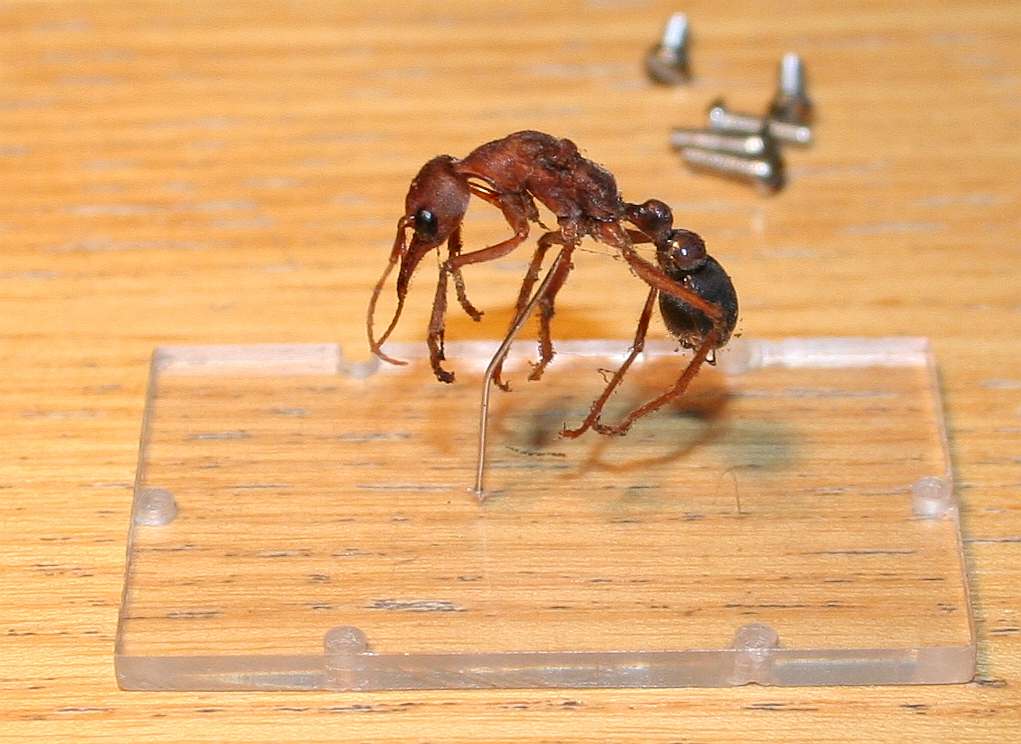
BULLDOG
ANT
- The real ant, all the way from Australia, is an exhibit at
Herstmonceux Museum.
ETYMOLOGY
Ants are social insects of the family Formicidae and, along with the related wasps and bees, belong to the order Hymenoptera. Ants evolved from wasp-like ancestors in the mid-Cretaceous period between 110 and 130 million years ago and diversified after the rise of flowering plants. More than 12,500 out of an estimated total of 22,000 species have been classified. They are easily identified by their elbowed antennae and a distinctive node-like structure that forms a slender waist.
Ants form colonies that range in size from a few dozen predatory individuals living in small natural cavities to highly organised colonies that may occupy large territories and consist of millions of individuals. Larger colonies consist mostly of sterile wingless females forming castes of "workers", "soldiers", or other specialised groups. Nearly all ant colonies also have some fertile males called "drones" and one or more fertile females called "queens". The colonies sometimes are described as superorganisms because the ants appear to operate as a unified entity, collectively working together to support the colony.
Ants have colonised almost every landmass on Earth. The only places lacking indigenous ants are
Antarctica and a few remote or inhospitable islands. Ants thrive in most ecosystems and may form 15–25% of the terrestrial animal biomass. Their success in so many environments has been attributed to their social organisation and their ability to modify habitats, tap resources, and defend themselves. Their long co-evolution with other species has led to mimetic, commensal, parasitic, and mutualistic relationships.
Ant societies have division of labour, communication between individuals, and an ability to solve complex problems. These parallels with human societies have long been an inspiration and subject of study. Many human cultures make use of ants in cuisine, medication, and rituals. Some species are valued in their role as biological pest control agents. Their ability to exploit resources may bring ants into conflict with humans, however, as they can damage crops and invade buildings. Some species, such as the red imported fire ant, are regarded as invasive species, establishing themselves in areas where they have been introduced accidentally.
The word ant is derived from ante of Middle English which is derived from æmette of Old English and is related to the Old High
German āmeiza, hence the modern German Ameise. All of these words come from West Germanic *amaitjo, and the original meaning of the word was "the biter" (from Proto-Germanic *ai-, "off, away" + *mait- "cut"). The family name Formicidae is derived from the Latin formīca ("ant") from which the words in other Romance languages such as the Portuguese formiga, Italian formica,
Spanish hormiga, Romanian furnică and
French fourmi are derived. It has been hypothetized that a
Proto-Indo-European word *morwi- was used, cf. Sanskrit vamrah, Latin formīca,
Greek myrmex, Old Church Slavonic mraviji, Old Irish moirb, Old Norse
maurr.
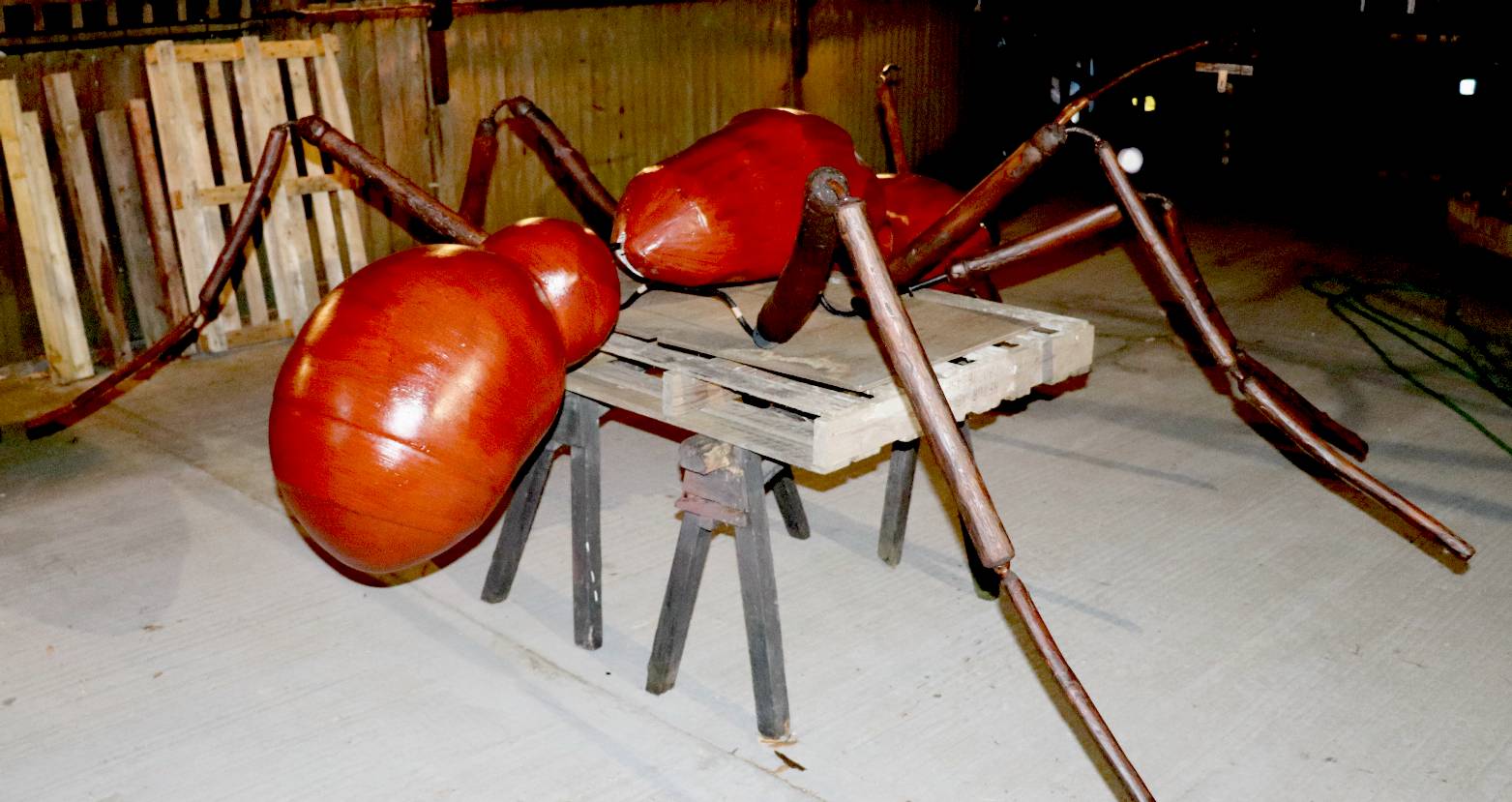
ROBOTICS
- As a machine, hexapods can traverse extremely rough terrain. At this
size, they can rescue humans, or walk on the surface of planets, where
Moon Buggies are unsuitable.
DISTRIBUTION & DIVERSITY
Ants are found on all continents except Antarctica, and only a few large islands such as
Greenland,
Iceland, parts of Polynesia and the Hawaiian Islands lack native ant species. Ants occupy a wide range of ecological niches, and are able to exploit a wide range of food resources either as direct or indirect herbivores, predators, and scavengers. Most species are omnivorous generalists, but a few are specialist feeders. Their ecological dominance may be measured by their biomass and estimates in different environments suggest that they contribute 15–20% (on average and nearly 25% in the tropics) of the total terrestrial animal biomass, which exceeds that of the vertebrates.
Ants range in size from 0.75 to 52 millimetres (0.030–2.0 in), the largest species being the fossil Titanomyrma
giganteum, the queen of which was 6 centimetres (2.4 in) long with a wingspan of 15 centimetres (5.9 in). Ants vary in colour; most ants are red or black, but a few species are green and some tropical species have a metallic
lustre. More than 12,000 species are currently known (with upper estimates of the potential existence of about 22,000) (see the article List of ant genera), with the greatest diversity in the tropics. Taxonomic studies continue to resolve the classification and systematics of ants. Online databases of ant species, including AntBase and the Hymenoptera Name Server, help to keep track of the known and newly described species. The relative ease with which ants may be sampled and studied in ecosystems has made them useful as indicator species in
biodiversity studies.

There are
several innovative vehicles and vessels on permanent display at
Herstmonceux Museum, including:
1.
Art
Gallery - Collection of paintings, pictures, graphics, sculptures,
wooden carvings & exotic glassware
2.
Archives - Historic documents library, patents, trademarks,
copyright, films, catalogued legal papers & letters
3. An
Edwardian ice well, throwback to the days before refrigeration
4.
A large underground (condensation/cooling) and water storage chamber for
ice making
5.
The world's smallest water
basin, test tank for model boats & ships to 1:20 scale
6.
World's smallest
wind tunnel, vehicle drag measuring instrument using electronic
strain-gauges
7.
Three
PV boat models,
Navigator, SWATH & 2 cats + route map prior to Swiss PlanetSolar
8.
Seavax, the ocean cleanup
proof of concept prototype from 2016 - Hall
of Plastic, ocean waste, marine litter Vs fish 2050
9.
AmphiMax, radio controlled (working) beach launching & recovery
vehicle for SeaVax
10.
Anthony the
most dangerous giant
Australian bulldog ant, 300 times normal size - Making
Ant's Cart
11.
EV - FCEV refueling station
model in 1:20 scale
12.
The only working
(fully functional) water well in Herstmonceux village
13.
The fountain of youth, Cleopatra inspired statue supplied from natural well water
drawn on site
14.
Second World War, 'Anderson Inspired,' bomb proof shelter constructed by Major Charles de Roemer
15.
City
sports FCEV-BEV, hydrogen gull wing proof of concept DC50 electric car
16.
Land speed record car: Bluebird-Electric BE1 (original 1st) with battery
cartridge exchange
17.
Land speed record car: Bluebird-Electric BE2 (original 2nd) with cartridge
exchange
18.
A complete mummified squirrel, found when re-roofing the Museum June
2017
19.
A fully operational, and restored VW Kombi van dating from 1978
(historic vehicle)
20.
BMW i3, battery electric vehicle hybrid, with onboard generator range
extender
21.
Solar panel,
and battery energy storage systems facing north-south and east-west
22.
A hornet's nest found on site & preserved in 2016 (reported as
[Asian] invasive species, to be safe)
23.
Three sewing machines, including an antique Singer and a Brother
industrial.
24. Adventure climbing frames for children (back to nature)
Swiss Family Robinson
25.
'Elizabeth
Swann' proof of concept model 1:20 scale hydrogen powered trimaran
26.
Holm
oaks, planting and growing trees from acorns on site, re-wilding in
Sussex
27.
Robotics, mechatronics, electronics and animatronics display - the
steel frame, head/jaws, &
drives of Anthony (coming soon)
28.
Dalek - Full size, drivable working model of the famous
Doctor Who BBC TV series,
and Peter Cushing film
29.
Films - Library
of VHS tapes, DVDs and BluRay classics, national treasures, greatest
hit, noir, oldies - from 1920
30.
PartArt4OW
- Proposal for an adapted & illustrated version of the Kulo-Luna
script, with local exhibit & art competition 2025
The
giant Australian Bull (or Bulldog) ant model, is not
in any way connected with the generating history of Herstmonceux
Museum, other than being built using their facilities, in
association with Jameson Hunter Limited, for their Sectasaur, and Magic
Dinobot, story development and special effects.
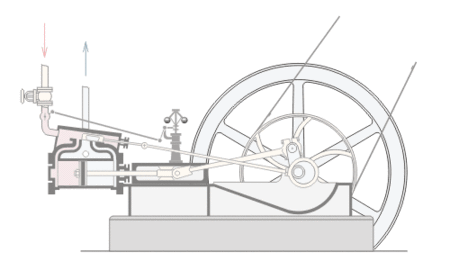
|
